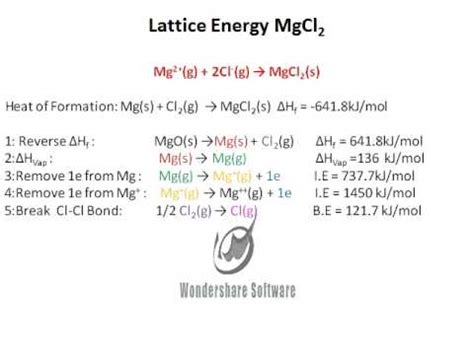Introduction

Magnesium chloride (MgCl2) is a ubiquitous ionic compound with a wide range of applications, from road deicing to food preservation. Understanding its lattice energy, the energy required to separate its constituent ions, is crucial for comprehending its chemical behavior. In this article, we will delve into the lattice energy of MgCl2, exploring its factors, applications, and implications.
Factors Influencing Lattice Energy
The lattice energy of MgCl2 is primarily influenced by:
- Charge of the ions: MgCl2 consists of doubly charged magnesium (Mg2+) and singly charged chloride (Cl-) ions. The greater the charge of the ions, the stronger their electrostatic attraction and hence the higher the lattice energy.
- Ionic size: The size of the ions plays a significant role. Smaller ions have a higher charge density and experience stronger electrostatic forces, resulting in a higher lattice energy.
- Interionic distance: The distance between the ions also affects the lattice energy. The closer the ions are to each other, the stronger the electrostatic attraction.
Calculating the Lattice Energy of MgCl2
The lattice energy of MgCl2 can be calculated using the Born-Lande equation:
U = -k * (Z1 * Z2 * e^2) / r * (1 - (1 / n)))
where:
- U is the lattice energy
- k is the Madelung constant, a factor that depends on the crystal structure
- Z1 and Z2 are the charges of the ions
- e is the elementary charge
- r is the interionic distance
- n is the Born exponent, an empirical parameter
Using the appropriate values for MgCl2, the calculated lattice energy is approximately 2328 kJ/mol.
Applications of MgCl2 Lattice Energy
Understanding the lattice energy of MgCl2 has various applications:
- Solubility prediction: The lattice energy is a key factor in determining the solubility of an ionic compound. A higher lattice energy indicates a higher energy requirement to separate the ions, making the compound less soluble.
- Crystal stability: The lattice energy provides insights into the stability of the crystal structure. A higher lattice energy indicates a more stable crystal.
- Phase transitions: The lattice energy influences the temperature and pressure at which phase transitions occur.
Emerging Applications: “Magneshale”
Inspired by the term “graphene,” a novel material called “magneshale” is proposed. It envisions sheets composed of MgCl2 molecules arranged in a layered structure, resembling graphite. This material could find applications in energy storage, catalysis, and sensing.
Useful Tables
Table 1: Properties of MgCl2
| Property | Value |
|---|---|
| Molecular weight | 95.211 g/mol |
| Melting point | 714 °C |
| Boiling point | 1412 °C |
| Density | 2.325 g/cm³ |
Table 2: Factors Influencing the Lattice Energy of MgCl2
| Factor | Effect on Lattice Energy |
|---|---|
| Charge of the ions | Higher charge results in higher lattice energy |
| Ionic size | Smaller ions result in higher lattice energy |
| Interionic distance | Shorter distance results in higher lattice energy |
Table 3: Applications of the Lattice Energy of MgCl2
| Application | Description |
|---|---|
| Solubility prediction | Higher lattice energy implies lower solubility |
| Crystal stability | Higher lattice energy indicates a more stable crystal |
| Phase transitions | Lattice energy influences transition temperatures and pressures |
Table 4: Lattice Energies of Common Ionic Compounds (kJ/mol)
| Compound | Lattice Energy |
|---|---|
| NaCl | 787 |
| KCl | 715 |
| CaO | 3456 |
| MgO | 3891 |
Conclusion
The lattice energy of MgCl2 plays a crucial role in its chemical and physical properties. By understanding the factors that influence this energy, we can predict its reactivity, solubility, and other characteristics. Ongoing research into emerging applications, such as “magneshale,” further highlights the potential of this versatile ionic compound.
